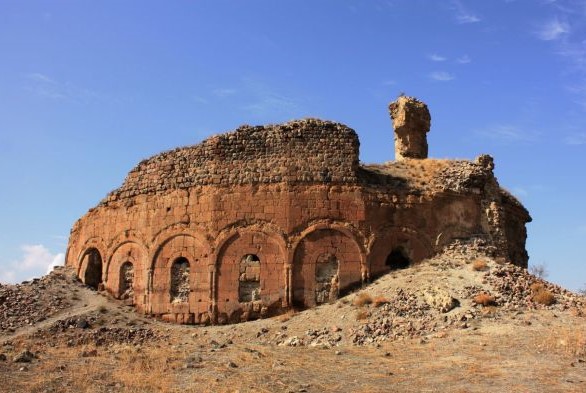Bana

Bana is an important ecclesiastical and state center of South-West Georgia in the territory of historical Tao (currently in Turkey). It is located 2 km from the present-day village Penek, on the right bank of the river Bani (Penek Çayı River), in the Chorokhi valley. A large cathedral was built here in the middle of the 7th century. During the reign of Adarnase II (888–923), the bishopric of Bana was founded, and the cathedral was rebuilt. Sometimes Bana was the tomb of kings.
Bana Cathedral is a prominent monument of ancient Georgian architecture. It is an original and complex building from the architectural standpoint. It belongs to the group of round temples along with Ishkhani (Tao), Lekit (currently in Azerbaijan) cathedrals and two Armenian monuments (Zvartnots and Gagkashen cathedrals). The plan is based on a tetraconch design with circular ambulatory. The walls of the ambulatory are connected with the central part of the church with semi-circular arches. Only the columns of the sanctuary apse stand on a raised, stone threshold. There are small rooms in all four corners between the four arms of the tetraconch, just like in the Mtskheta cross-type monuments. But unlike them, there are two more floors on top of these rooms, which means that there are three-tiered rooms. These corner pieces were also the main piers on which the dome rested. The external part of the cathedral consists of two cylinders: the lower one is wider, corresponds to the body of the building, includes the tetraconch itself, the surrounding area and the second floor ambulatory on top of it; The second one is the neck of the dome, the diameter of which is much smaller (up to 10 m). The height of the inner space reached 32 m, the diameter of the base – 38 m. The interior decoration of the church is interesting, in particular, the round columns with original capitals, which are a modified version of the Ionic capitals. From the outside, the entire circumference of the lower cylinder is followed by a continuous row of decorative arches. Inside, in the apse of the sanctuary, under the arches of the rooms on the second and third floors, there are traces of plaster and frescoes. The inside and outside of the church is built with cut stone. It turned out to be the most structurally complete of the monuments of this type. It was relatively well preserved until the 19th century. During the Crimean War (1853–1856), the Turks turned it into a fortress, added a superstructure and built two towers in the south and east sides. It gradually collapsed in later years. Information about Bana can be found in the writings of explorers-travelers of the first half of the 19th century, but first research about it belongs to E. Takaishvili, who was there in 1902–1907. Thanks to his expeditions, the measurements and reconstruction of the Bana Cathedral made by the architects S. Kldiashvili (1902) and A. Kalgin (1907) were preserved.
To the north of the great cathedral, outside the fence, there are the ruins of a small tetraconch, to the southeast there are caves in the rocks, in one of them there is a small aisleless church. There is little information about the literary activities that had started in Bana. We can name only Zakaria Baneli (10th–11th centuries) among the prominent figures here. It was under his leadership that several valuable manuscripts were produced.
Literature: მ ე ნ ა ბ დ ე ლ., ძველი ქართული მწერლობის კერები, ტ. 1, ნაკვ. 2, თბ., 1962; მ ე ფ ი ს ა შ ვ ი ლ ი რ., თ უ მ ა ნ ი შ ვ ი ლ ი დ., ბანას ტაძარი, თბ., 1989; ჩ უ ბ ი ნ ა შ ვ ი ლ ი გ., ქართული ხელოვნების ისტორია, ტ. 1, ტფ.,1936; Б е р и д з е В. В., Архитектура Тао-Кларджети, Тб., 1981; Т а к а й ш в и л и Е., С., Христианские памятники, «Материалы по археологии Кавказа», 1909, в. 12.
V. Beridze
L. Menabde


